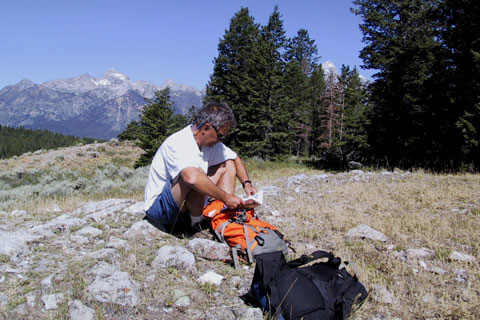| 525 | Trail Sense Navigation - Where Am I? |
2011-11-28 |

There are three key elements to navigation: Where am I ( position), where am I going (destination), and how am I going to get there (route). All members of a hiking group should know all three for each hike.
Through the years we have met a lot of hikers who were lost. In Rocky Mountain National Park last summer ('11) we were close to a major trailhead when we met a family on the trail who were exhausted. They had no idea where they were. They were lost and were no more than a quarter of a mile from the trailhead. (This story will be in Friday's - Summer Stories, so more on the story later in the week ... ) We talked with them a bit and then made sure they knew just to walk down the hill (for a few minutes) to a major parking area. Buses, then would take them to wherever they parked.
We felt sorry for the family. They were not having fun and probably were going to hang up their hiking shoes after this bad experience. All they needed for a successful trip was a better understanding of the key navigation skill of knowing their position - where am I?.
A few tips to help find yourself or where am I?
Carry the gear:
- Map.
- Pen or pencil.
- Watch.
- Guidebook or copied pages from the guidebook.
- Compass and/or GPS.
Learn to find true north on the compass (more next week).
Learn to orient the map to true north.
Read the guidebook before leaving the trailhead. Make notes.
Look for key simple fixes (known positions) on the map, such as where the trail intersects with another trail or crosses a stream, or key geographic feature, etc
Know the mileages to each known position.
Keep track of the time to walk to each position.
Ask everyone in the group to also read the map and guidebook information.
Consult the guidebook and map often, while hiking. At junctions, even if you think you know where you are going, still check the map.
Remember not all trails are on a map and some trails may have been changed.
Stop and think, if you think something is wrong. It is okay to turn around. It is a must that you pull out all of your aids to navigation and confirm your position, destination, and route.
If you are fatigued, you are more likely to make poor decisions.
Where am I navigation or the simple fix:
Before leaving the trailhead, make a mileage list of known positions and their mileage. Most guidebooks include mileages; but some make you dig.
Note the time you leave the trailhead. Check the map one last time. Also, look for any current information on the trailhead kiosk, if available.
Note the time and distance when you arrive at each known position. These positions arethe ones you included on the list you made before starting the hike.
Calculate your speed. Your hiking speed might change during the day; but at least know your general speed, then adjust it accordingly.
For a close approximation of your location, multiple your speed times the time from last know position, then plot the location on the map with the time of day.
Example - The last known position was a creek crossing at 1.2 miles. You know the next position is in 1.5 miles, when the trail reaches a ridge crest. You left the last known position at 0830 and now it is 0900. You calculated you hiking speed was 2 miles per hour.
You should be close to mile 2.2 (you traveled 1 mile in 30 minutes) and you should reach the ridge in about 15 minutes. Plot the location with the time and continue walking.
A GPS allows you to mark the position with time, elevation, and coordinates.
If you check the mileage at one of the 6 minute intervals (6, 12, 18, 24, 30, etc), it is easy to convert the minutes to a percentage of an hour - .10 of an hour is 6 minutes, .50 is 30 minutes. This makes calculating in your head much easier! : )
I have heard some hikers say they have a great sense of direction. I have probably said that a few times myself; but I do not think it is really true of myself. The reason it seems like I have a good sense of direction is because I study maps. I make notes and I make a conscious effort to always know where I am. I truly work at knowing my location. Of course, I think the whole navigation process makes hiking more fun.
Happy I Know Where I Am trails
Trail Sense - Navigation - Where Am I?
Trail Sense - Navigation - Where Am I Going?
Trail Sense - Naviagtion - How Do I Get There?